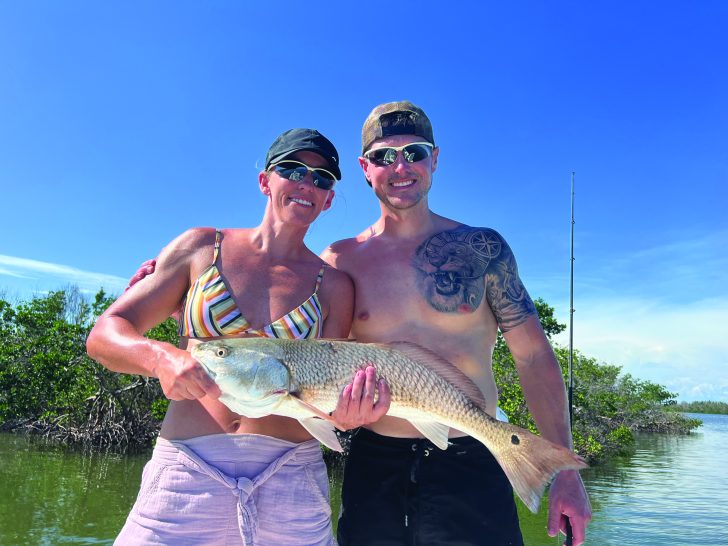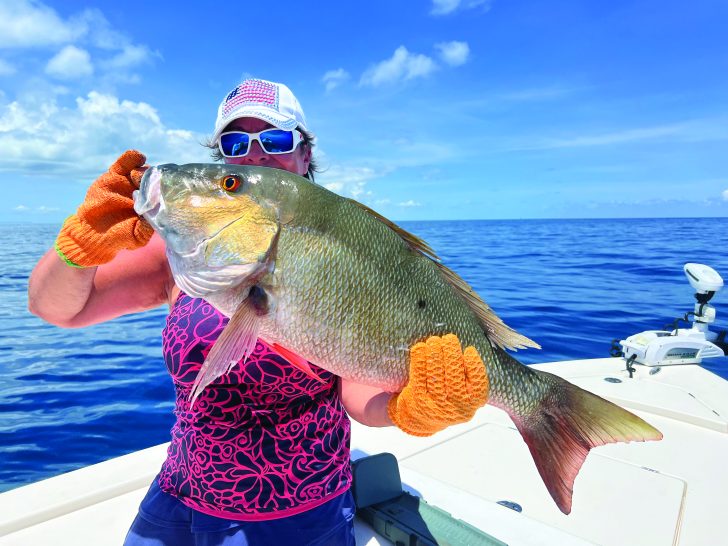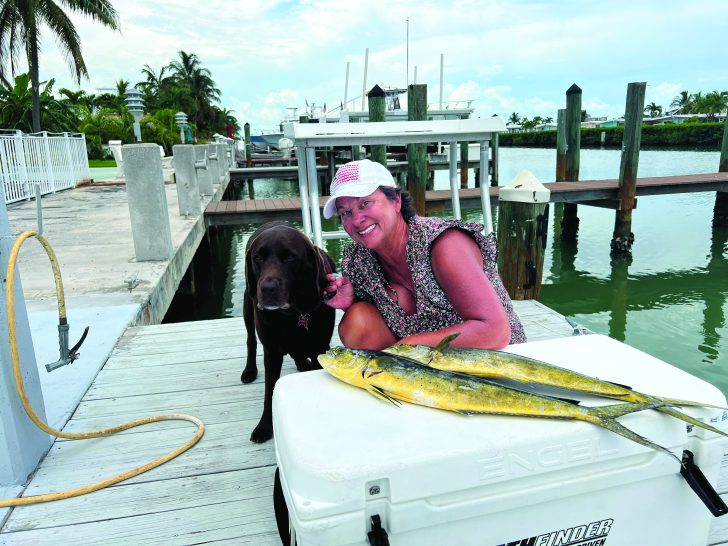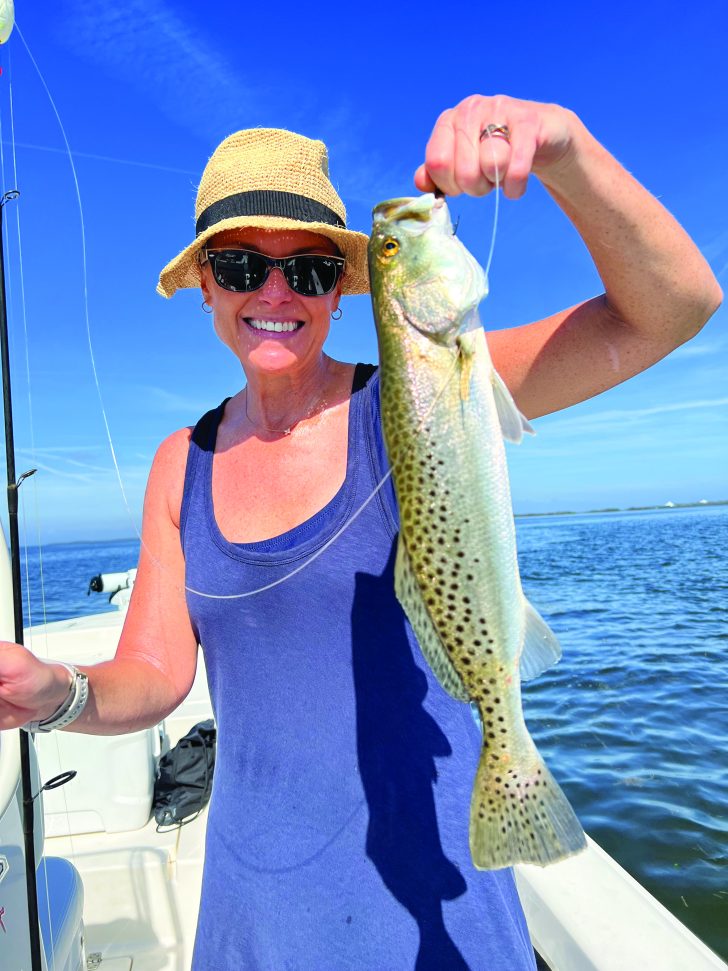by: Capt. Terry Fisher
September is one of the few months that 1st Mate Vicki, 2nd Mate Moby ‘Dick’ and I take every opportunity to ‘fish for fun’! Trips to the Florida Keys (‘Keys’) or fishing for snook and redfish locally, between charter requests, fill up our schedules and support our lifestyle. Last month offered opportunities to vacation and travel to the Marathon and Key West areas to enjoy our boat and the ‘Salt Life’! Vicki and I were in Marathon the second week of August to catch dorado, tuna, grouper and snappers. Just coming off a full moon enhanced the snapper bite. Naturally, 1st Mate Vicki seems to almost aways do better on the reefs than I do (she has a lot more patience is the only thing I can figure out, plus the fact that she loves it).
The last few days of August found us back on the 36 ft. Yellowfin of Ron and Lucinda Defreitas fishing the Dry Tortugas and the Florida Straits between Key West and Havana. Vicki and I have another trip planned with our vessel at the end of this month to Duck Key at Hawk’s Cay, joining the Maverick Boat Company and other Pathfinder owners for a fun filled weekend which includes a ‘friendly’ fishing tournament, music, food and beverages.
When we weren’t ‘on the road’ or on the ‘high seas’, I fished clients here both inshore and offshore with good results and offer the following summer tips:



Inshore; early morning on high tides for redfish, snook, mangrove snappers and seatrout. shrimps, blue crabs (quartered) will be good offerings for the redfish around the mangroves, pilchards for snook off the beaches, shrimp for mangrove snappers and seatrout.
I prefer to fish the redfish on the high incoming tide when the fish are moving out of the potholes to oyster beds and the mangroves which hold food, provides shelter from the summer heat and protection from osprey’s, eagles and dangers that lie beneath the surface.
Snook fishing will be more productive just off the beaches where they are still feeding and spawning. Pilchards, live finger mullet and pinfish will provide the best action. These fish will be working the beach areas around grasses and stumps. They will be in shallower, rather than deeper water, in one of the two ‘troughs.
Mangrove snappers will be caught wherever there is structure, rocks, wood piles and mangroves. Use a shrimp on a small hook and small weight with a 20lb. leader for good results.
This time of year, especially with the extreme heat we have experienced, I suggest fishing deeper for seatrouts. Instead of 4-5ft., try 5-6ft. over the grass beds. Expect to catch a lot of smaller fish. I suggest artificial soft plastic or live shrimp under a popping cork. However, if these fish are feeding on the surface, give a top water a try. The secret for catching legal size for harvest, is to move around and keep trying. Use lighter tackle to get the most out of your fishing experience. Expect to catch a lot of catfish.
Offshore winds are always the determining factor for a trip offshore. My ‘rule of thumb’ is if it is over 12-13mph, I will not go out, especially with a southerly wind. 10mph or less is ideal. The bigger grouper, snapper, trigger fish and other species are being caught 50-70 miles offshore in 150-160ft. of water. Hopefully, as we approach October the water temperatures will cool enough to bring more big fish within 80-120ft. range. Be aware of the regulations for both state and federal harvesting and possession laws, including closures due to over harvesting and other variables.
Most offshore species can be caught with shrimps, squid, pinfish and mullet dropped to the bottom. Keep a look out for bait on the water with birds diving. The last couple of months the gulf waters have been ‘alive’. 1st Mate Vicki and I were out before the closure of red grouper and witnessed a lot of healthy fish signs. I spotted a 12- 14ft. great white shark just below the surface (10 feet off the stern of the boat) headed toward one of the three huge fish feeds around us. Being a Certified Scuba Diver, I have experienced many shark encounters. I admit this sighting gave and still gives me an ‘eerie’ feeling. None the less, we loaded up on lane and mangrove snapper before the day was done. We caught our share of red grouper, but they included a lot of small ones since we were fishing 90-110 ft. of water.
In regard to equipment, whether inshore or offshore, I recommend that anglers go with lighter with smaller gear. It is more fun and much more rewarding. Don’t use anything that is bulky and heavy. Use equipment that will get the job done by ‘tiring’ and controlling the fish, rather than equipment that will tire out the angler.

